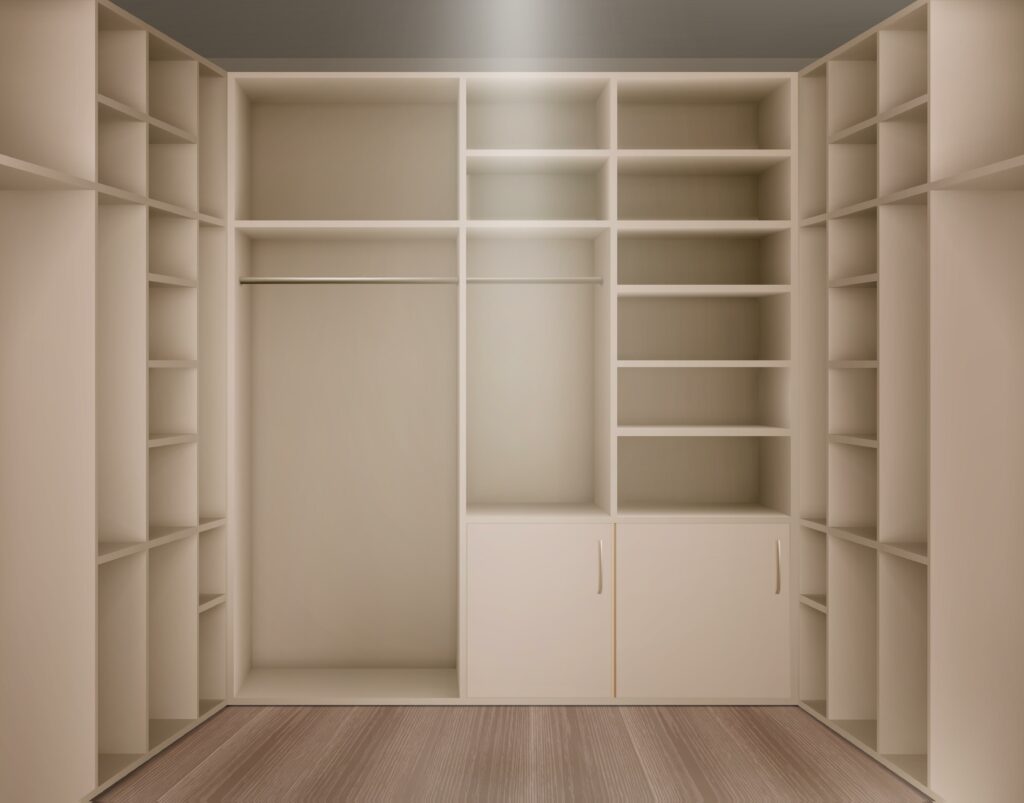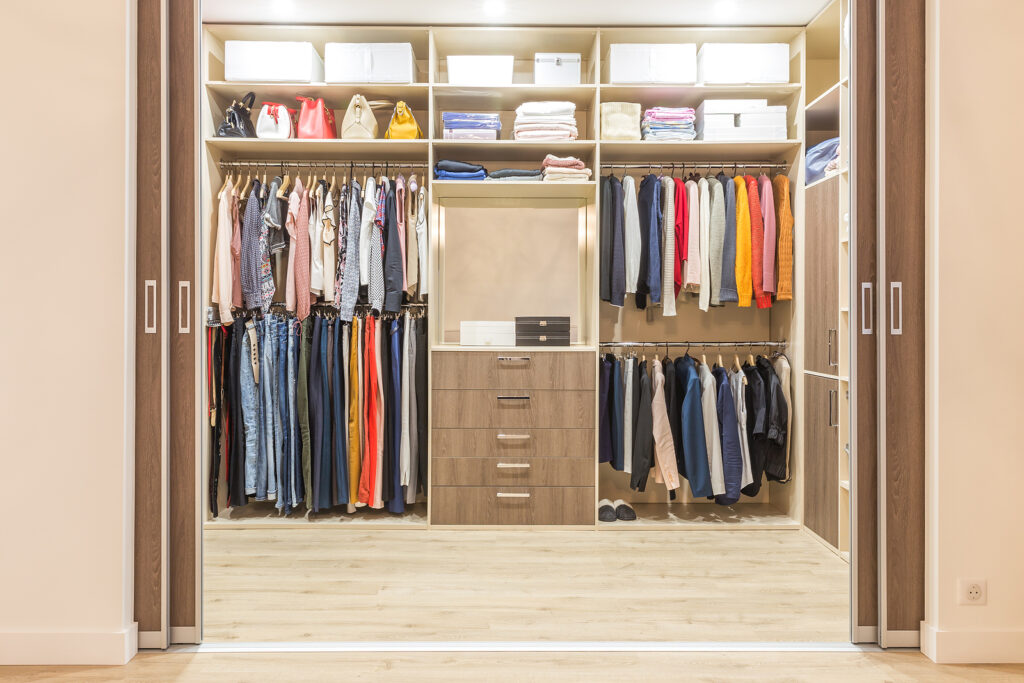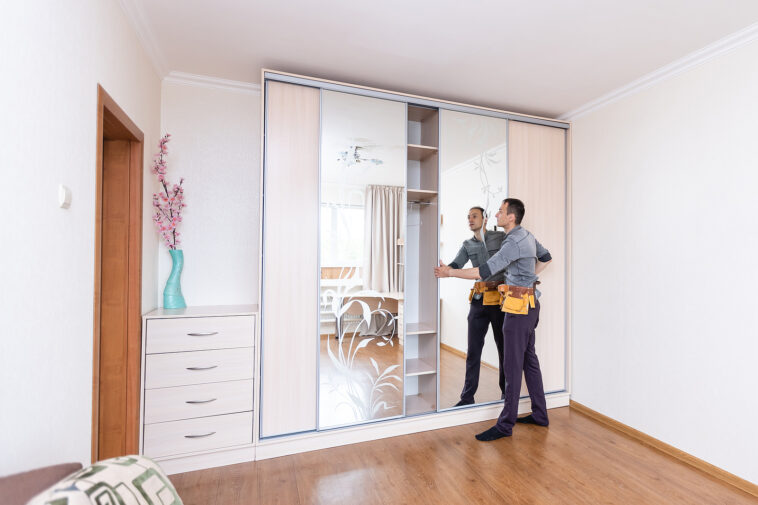In today's ever-evolving world of interior design and home improvement, DIY fitted wardrobes have emerged as a remarkable trend. These customized closet solutions not only provide an efficient way to maximize your storage space but also inject a sense of elegance and personalization into your living spaces.
Whether you're a seasoned DIY enthusiast with an array of tools at your disposal or a complete novice eager to embark on your first home improvement project, this extensive guide is designed to walk you through every intricate detail of creating your very own DIY fitted wardrobe.
From meticulous planning and design considerations to the step-by-step construction process and those all-important finishing touches, we'll delve deep into the intricacies of this undertaking. Let's embark together on your journey to achieving a well-organized and stylish closet space that reflects your unique taste and needs.
Why Choose DIY Fitted Wardrobes?
When contemplating home improvement projects, you might wonder why DIY fitted wardrobes are a compelling choice. To start, these wardrobes are designed to be tailor-made for your specific needs and the dimensions of your available space, guaranteeing optimal utilization of every inch. Moreover, embarking on a DIY project can be a cost-effective endeavor, allowing you to save significantly on labor costs. Let's delve deeper into the rationale behind choosing DIY fitted wardrobes.
DIY Fitted Wardrobes: A Smart Choice
DIY fitted wardrobes offer a plethora of benefits that set them apart from store-bought alternatives. One of the primary advantages is the level of customization they provide. These wardrobes can be meticulously designed to match your exact storage requirements, ensuring that every nook and cranny is maximized for functionality.
Another compelling reason to consider a DIY approach is the potential for substantial cost savings. By investing your own time and effort into the project, you can significantly reduce labor costs associated with hiring professionals. Additionally, you have the freedom to select materials that align with your budget without compromising on quality.
Furthermore, DIY-fitted wardrobes allow you to showcase your creativity and craftsmanship. You'll take pride in knowing that you've created a customized storage solution that not only meets your needs but also aligns with your style and preferences.
Check out our post on DIY Tools
Planning Your DIY Fitted Wardrobes
Assessing Your Needs
Before you even pick up a tool, it's imperative to conduct a thorough assessment of your storage needs. Take inventory of the types of clothing, accessories, and other items that will inhabit your wardrobe. This step lays the foundation for determining the number of shelves, hanging rods, drawers, and other storage elements that your fitted wardrobe will require.
Setting a Budget
Establishing a budget is a pivotal part of your project's success. It will serve as your guiding light when making decisions about materials, design elements, and additional features. Remember that while DIY projects can save money, investing in high-quality materials and hardware is crucial for long-lasting and durable results.
Choosing the Right Location
The location of your DIY fitted wardrobe is a critical consideration. Common placements include bedrooms, walk-in closets, or under-stair storage areas. Ensure that your chosen location can accommodate the size and design of your envisioned wardrobe.
Measuring Your Space
Accurate measurements are the backbone of your DIY fitted wardrobe project. Invest the time and effort to measure the height, width, and depth of your available space meticulously. Additionally, be vigilant about noting any obstacles, such as pipes or electrical outlets, that might affect your design and construction process.

Designing Your Fitted Wardrobe
Style and Aesthetics
When designing your fitted wardrobe, it's essential to take into account the overall style and aesthetics of your home. Your goal is to ensure that the finished product seamlessly blends with your existing decor. Choose a design that complements your home's interior, whether it leans towards modern, traditional, or finds itself in the midst of these styles.
Interior Layout
The interior layout of your fitted wardrobe is where functionality meets personalization. Plan meticulously to determine the number and arrangement of shelves, hanging rods, drawers, and other organizational elements. Think about how you want to categorize and store your clothing and accessories efficiently.
Materials and Hardware
Selecting high-quality materials is paramount to the success of your DIY fitted wardrobe. Common materials include plywood or medium-density fiberboard (MDF) for the frame and shelves. When it comes to hardware, invest in sturdy and reliable options for doors, handles, and drawer slides. The choice of materials and hardware will play a significant role in ensuring the longevity and durability of your wardrobe.
DIY vs. Professional Design Services
While DIY design can be immensely rewarding, some homeowners opt for professional design services to create the perfect wardrobe layout. Experienced designers bring a wealth of knowledge and creative solutions to the table, which can be particularly advantageous if you're seeking a unique or complex design. Assess your needs and preferences to decide whether you'd like to tackle the design yourself or enlist the expertise of a professional.
Check out our post on DIY Tools
Gathering Materials and Tools
Once your design is finalized, the next step is to create a comprehensive list of materials and tools necessary for your DIY fitted wardrobes project. A well-prepared list will save you time and ensure that you have everything you need at your disposal when you begin construction.
Common materials include
- Plywood or MDF sheets for the frame and shelves.
- Screws, nails, and dowels for assembly.
- Edge banding to finish exposed edges.
- Paint or stain for the finishing touch.
- Hardware such as handles, knobs, pulls, and hinges.
- LED strip lights or motion-activated sensors for lighting solutions.
Essential tools to have on hand include
- A saw for cutting materials to size.
- A drill for making holes and attaching hardware.
- Measuring tape and a level for precise measurements and alignments.
- Sandpaper for smoothing surfaces and edges.
By having all the necessary materials and tools ready, you can streamline the construction process and reduce potential delays.
Building Your DIY Fitted Wardrobes
Constructing the Frame
With materials and tools in hand, you're ready to dive into the construction phase of your DIY fitted wardrobes. Start by constructing the frame, which serves as the structural backbone of your wardrobe. Begin by cutting plywood or MDF sheets to the required sizes based on your design.
Assemble the frame according to your design's specifications. Take care to ensure that the frame is level and securely anchored to the wall. Properly securing the frame is crucial, as it provides stability and ensures that the rest of your wardrobe's components fit seamlessly.
Installing Shelves and Hanging Rods
With the frame in place, the next step is to install the shelves and hanging rods inside your fitted wardrobe. Utilize appropriate brackets, supports, and fasteners to guarantee the stability and load-bearing capacity of these elements.
The arrangement of shelves and hanging rods should align with your design layout and accommodate the specific items you intend to store. Consider your clothing collection, the need for shoe storage, and any specialized accessories or organizational elements you desire. This is where the customized nature of DIY fitted wardrobes truly shines, as you can adapt the interior to suit your unique needs.
Adding Doors
Installing doors is a pivotal phase in bringing your DIY fitted wardrobes to fruition. Doors not only serve as functional barriers to keep your clothing and belongings neatly concealed but also contribute significantly to the overall aesthetics of the wardrobe.
When it comes to selecting doors, you have a variety of options at your disposal. Hinged doors, sliding doors, and even curtain doors can all be viable choices, depending on your design preferences and space constraints. Take great care to properly align and install the chosen doors, ensuring that they open and close smoothly and securely.
Customization Options
One of the standout features of DIY fitted wardrobes is the ability to incorporate custom elements that enhance functionality and convenience. Consider adding built-in drawers, specialized shoe racks, pull-out accessory trays, or even integrated dressing mirrors to elevate the utility of your wardrobe.
These customization options allow you to create a bespoke storage solution tailored precisely to your preferences and daily routines. By carefully planning and implementing these features, you can enhance the overall usability and organization of your wardrobe.
Finishing Touches
Painting or Staining
As the construction phase nears completion, it's time to turn your attention to the finishing touches that will give your DIY fitted wardrobes a polished and cohesive appearance. One of the most impactful finishing options is painting or staining the wardrobe's surfaces.
Choosing a finish that complements your home's decor and your design vision is essential. Whether you opt for a bold and vibrant color, a timeless and elegant stain, or a subtle and neutral palette, the finishing touches can elevate your wardrobe's aesthetics to new heights. To achieve a professional look, apply multiple coats, sanding between layers for a smooth and even finish.
Hardware Installation
The installation of handles, knobs, pulls, and hinges is another crucial aspect of the finishing process. These hardware elements not only contribute to the functionality of your wardrobe but also add character and style.
Select hardware that aligns with the overall design and aesthetics of your fitted wardrobe. Pay meticulous attention to alignment and positioning to ensure that doors and drawers operate seamlessly. Properly installed hardware enhances both the visual appeal and usability of your wardrobe.
Lighting Solutions
To further enhance the functionality of your fitted wardrobe, consider adding lighting solutions. Illuminating the interior of your wardrobe can make it easier to locate and organize your belongings effectively. There are several options to consider:
- LED strip lights: These energy-efficient and low-profile lights can be installed along the edges of shelves or along the top frame to provide uniform illumination.
- Motion-activated sensors: For added convenience, you can incorporate motion-activated sensors that automatically turn on the lights when you open the built in wardrobe doors diy. This is particularly useful for walk-in closets or large built in wardrobes diy.
- Adjustable spotlights: If you want to highlight specific sections of your wardrobe, adjustable spotlights can be installed to focus light where it's needed most.
The choice of lighting solution should align with your wardrobe's design and your specific storage needs.
Final Adjustments
After completing the construction and finishing touches, take the time to perform a final inspection of your DIY fitted wardrobes. Ensure that all doors and drawers function correctly, opening and closing smoothly without any hitches. Make any necessary adjustments to guarantee a seamless fit and an optimal user experience.

Maintenance and Care
To ensure that your DIY fitted wardrobes stand the test of time, it's essential to establish a routine maintenance and care regimen. Regular upkeep will not only preserve the aesthetics but also extend the lifespan of your custom closet solution.
Here are some key maintenance and care practices to consider:
- Regular cleaning: Dust and wipe down the interior of your wardrobe regularly to prevent the buildup of dirt and debris. Use a damp cloth or a gentle cleaning solution as needed.
- Lubrication: Periodically lubricate hinges, drawer slides, and any moving parts to ensure smooth and effortless operation.
- Inspection: Conduct routine inspections to check for any signs of wear, damage, or loosened hardware. Promptly address any issues to prevent further deterioration.
- Seasonal adjustments: Depending on environmental factors such as temperature and humidity, you may need to make seasonal adjustments to the fit and operation of doors and drawers.
- Avoid overloading: Be mindful not to overload shelves and hanging rods beyond their weight-bearing capacity to prevent structural damage.
By incorporating these maintenance and care practices into your routine, you can enjoy your DIY fitted wardrobes for many years to come, ensuring that they remain both functional and aesthetically pleasing.
The Many Benefits of DIY Fitted Wardrobes
The decision to embark on a DIY fitted wardrobes project is not one to be taken lightly. It's essential to understand the full spectrum of benefits that these custom closet solutions can offer to homeowners. Let's explore the numerous advantages that come with choosing DIY fitted wardrobes.
Customization
The hallmark feature of DIY fitted wardrobes is the level of customization they offer. Every aspect of the wardrobe, from the interior layout to the finishing touches, can be tailored to meet your specific needs and preferences. This results in a storage solution that is uniquely yours, accommodating your clothing collection, accessories, and organizational preferences with precision.
Cost Savings
One of the most compelling reasons to opt for DIY fitted wardrobes is the potential for substantial cost savings. By investing your own time and effort into the project, you can significantly reduce labor costs associated with hiring professionals. Additionally, you have the freedom to select materials and hardware that align with your budget without compromising on quality.
Personal Satisfaction
Undertaking a DIY project is not only about the end result; it's also about the journey. Crafting your own fitted wardrobe allows you to showcase your creativity and craftsmanship. The sense of personal satisfaction and accomplishment that comes with completing such a project can be immensely rewarding.
Increased Home Value
DIY fitted wardrobes have the potential to add significant value to your property. These customized closet solutions enhance the functionality and aesthetics of your living spaces, making your home more appealing to potential buyers or renters.
Optimal Space Utilization
One of the primary objectives of any wardrobe is to maximize space utilization. DIY fitted wardrobes excel in this regard, as they are designed to fit seamlessly into your available space, leaving no gaps or wasted areas. The result is a storage solution that efficiently utilizes every square inch.
Improved Organization
Effective organization is at the core of any successful wardrobe. With DIY fitted wardrobes, you have the freedom to create a layout that suits your organization needs. Whether you require specialized sections for shoes, accessories, or seasonal clothing, you can design your wardrobe to cater to your unique storage requirements.
Enhanced Aesthetics
Beyond functionality, DIY fitted ward robes bring a touch of elegance and sophistication to your home's interior. By designing the wardrobe to harmonize with your existing decor and style preferences, you can create a seamless and visually appealing addition to your living spaces. The carefully selected materials, finishes, and hardware contribute to the overall aesthetic appeal, making your wardrobe a statement piece within your home.
Unlimited Design Possibilities
DIY fitted wardrobes offer boundless design possibilities. You are not constrained by the limitations of off-the-shelf options; instead, you have the freedom to experiment with various layouts, styles, and features. This versatility allows you to craft a wardrobe that not only meets your immediate needs but also adapts to future changes in your lifestyle or storage requirements.
Sustainable and Eco-Friendly
Crafting your own fitted wardrobe gives you control over the materials you use. This provides an opportunity to prioritize sustainability and environmental consciousness. Opt for eco-friendly materials, finishes, and hardware to reduce your ecological footprint while creating a functional and beautiful storage solution.
Unique Features
DIY fitted wardrobes offer the flexibility to incorporate unique features that cater to your specific preferences. Whether you desire a built-in dressing table, a dedicated section for jewelry, or hidden compartments for valuables, you have the creative freedom to make your wardrobe truly one-of-a-kind.
Investment in Longevity
When you undertake a DIY fitted wardrobes project, you have a vested interest in its longevity. You're more likely to use high-quality materials and construction methods to ensure that your creation stands the test of time. This investment in durability pays off in the form of a wardrobe that remains sturdy and functional for many years.
Personalized Storage Solutions
No two individuals have the exact same storage needs. DIY fitted wardrobes allow you to customize your storage solutions to suit your lifestyle and preferences. From spacious shelves for shoe collectors to dedicated tie and belt racks for the sartorially inclined, your wardrobe can cater to your unique storage requirements.
Reduced Clutter and Stress
An organized and well-designed wardrobe can significantly reduce clutter and stress in your daily life. With everything in its place and easily accessible, you'll spend less time searching for items and more time enjoying a stress-free morning routine.
Conclusion
Embarking on the journey of creating your DIY fitted wardrobes is an exciting endeavor that can transform not only your storage space but also the overall functionality and aesthetics of your home. This comprehensive guide has walked you through the entire process, from the initial planning stages to the final finishing touches. By meticulously assessing your needs, setting a budget, and carefully designing your wardrobe, you've set the stage for a successful project.
Throughout the construction phase, attention to detail is key, from building a sturdy frame to installing shelves, hanging rods, and doors. The customizability of DIY fitted wardrobes allows you to tailor every aspect to your liking, from the color of the finish to the choice of hardware and lighting solutions. Remember that proper maintenance and care will ensure the longevity of your creation, allowing you to enjoy its benefits for years to come.
The benefits of DIY fitted wardrobes are multifaceted, ranging from customization and cost savings to increased home value and enhanced organization. By crafting a wardrobe that aligns with your unique needs and style preferences, you're not only creating a functional storage solution but also a statement piece that elevates the aesthetics of your living spaces.
Sources
https://www.screwfixwardrobes.com/building-a-fitted-wardrobe
https://www.diy.com/home-furniture-storage/furniture/bedroom-furniture/fitted-wardrobes.cat




